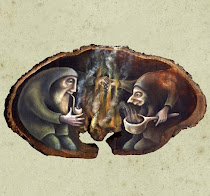THE MOMENT of putting pencil to pristine paper begins in an artist a process that is described in myths and in alchemical texts, on spiritual paths and in psychologists' consulting rooms, on esoteric quests and in our dreams at night...
I prefer not to plan my paintings very heavily, and my sketchbooks contain just very rough draughtswoman's notes as to the vague placing of things within a frame. I like to save the real magic for the actual final painting. For me, the shamanic process of coaxing out entities from the page and deciding the most beautiful trajectory for a line needs to take place within the object itself, for it to become an object of power. If I drew the whole thing out in draught and then copied it to the canvas, it would be dead and remain leaden.
And for the purposes of this work, I am concerned with transforming that lead into gold.
I always listen to music when I work; I find it takes me easily into the otherworld I need to dwell in to be able to work magically. Music is a dear and important part of my artistic life. I love to play and to listen, and I am endlessly fascinated by the shifts it causes in me: the movements in my soul.
Some many moons ago, I was on a train listening to music on my headphones, and drawing in my sketchbook at the same time. Perhaps because I was actually hurtling along simultaneously, the conjunction of overwhelmingly moving music and creation, caused me to consider the alchemical process that is art.
It struck me that the musicians who had composed and played this music were putting the same heart into it which I put into my painting, and that consequently, I was being moved, being transformed by listening to the work of these musicians whilst drawing. I wondered at the thread of soul which goes into a work of art - be it music or writing or painting or dance or theatre or whatever - and then leaks out again upon it being experienced. It then goes into that person standing before the work of art, and actively changes them. What then comes out of that person is coloured by the particular magical thread they've taken hold of in falling under the spell of that piece of art.
Words and an idea came then, on that train, about the role of artist as alembic, where the transformation necessary for making gold happens within the artist, but also, crucially, within the artwork. This is why beautiful things created with soul matter: they set running a series of alchemical reactions inside human beings, that are vital for living a meaningful life. The creation and imbibing of these beautiful things is just as necessary to us as is the husbandry and nourishment of food.
And so I began a painting of an alchemist. This Alchemist is an artist and a young woman. She sits cross-legged in an arched palette-mandala of phoenix-fiery transformation. Around her head flies a golden nimbus of musicians, undoubtedly playing the East European folk music of my soul. From their instruments and mouths come ribbons of song, stitched with a poem, and many-coloured. This ribbon winds down through our Alchemist's dress, and becomes the coloured stripes of the fabric. In her hands she holds her own heart, which takes in and bleeds out this ribbon of song, this thread of soul, as if it is her own blood. On it flows, down her dress, through her, until it reaches the hem of her dress. There it trickles off into many paint jars to become the pigment with which she will create her magic thereafter.
The painting of this piece mapped my own personal transformations, and became for me precisely what I sought to describe in painting it. It took a long time, many months. I stopped working on it at some points, and concentrated on other, less potent works. But this one still called me, and I finally completed the work.
Underneath the Alchemist is a word in golden Cyrillic letters - Алхимичка. It means Alchemist, but I’ve feminized the ending. There isn’t really a word for a woman-alchemist, and I’m told that this word might sound rather ridiculous to Russians.
This painting rests on a pivot on which balance many spectrums... music:painting, sound:vision, red:violet, above:below, sun:moon, masculine:feminine, invisible:visible, ash:phoenix, and so on... The most obvious pivot is the place of intersection of the two circles, within which Venn-space is held the heart, the place where I feel physically these transformations taking place in me.
Last I added gold and words; soon I will frame the painting, perhaps as if it was an icon.
I am astounded by this painting, (which is extremely unusual for me in relating with my own work) and more so by the fact that it looks nothing like I imagined it would when I thought it up back then on that train. It is a kaleidoscope of gold and jewel colours and magic and music, it has painted me, and I almost don't know how it happened.



by
© Rima Staines 2012
This soaring song,
The musicians' brew
of heart-chord changes,
and pieces of you;
O liquorice liquor
as black as a hole,
replenish the belly
of my samovar-soul.
This artist's body:
alembic of love,
transfigures the liquor
of song from above,
And paints out the colours
of humanity's tale;
a golden translation:
What it is to be frail.
~~~~~~~~~~~~~~~~~~~~
Small postscript...
- The spell-poem above is what's written in the painting in the threads of song.
- This painting (as well as my Rise & Root piece) is being published in the third Dark Mountain book, which is available for pre-order now.
- There are two sizes of archival giclée prints of The Alchemist available in my shop now, as well as other, smaller prints.




























































.jpg)





































